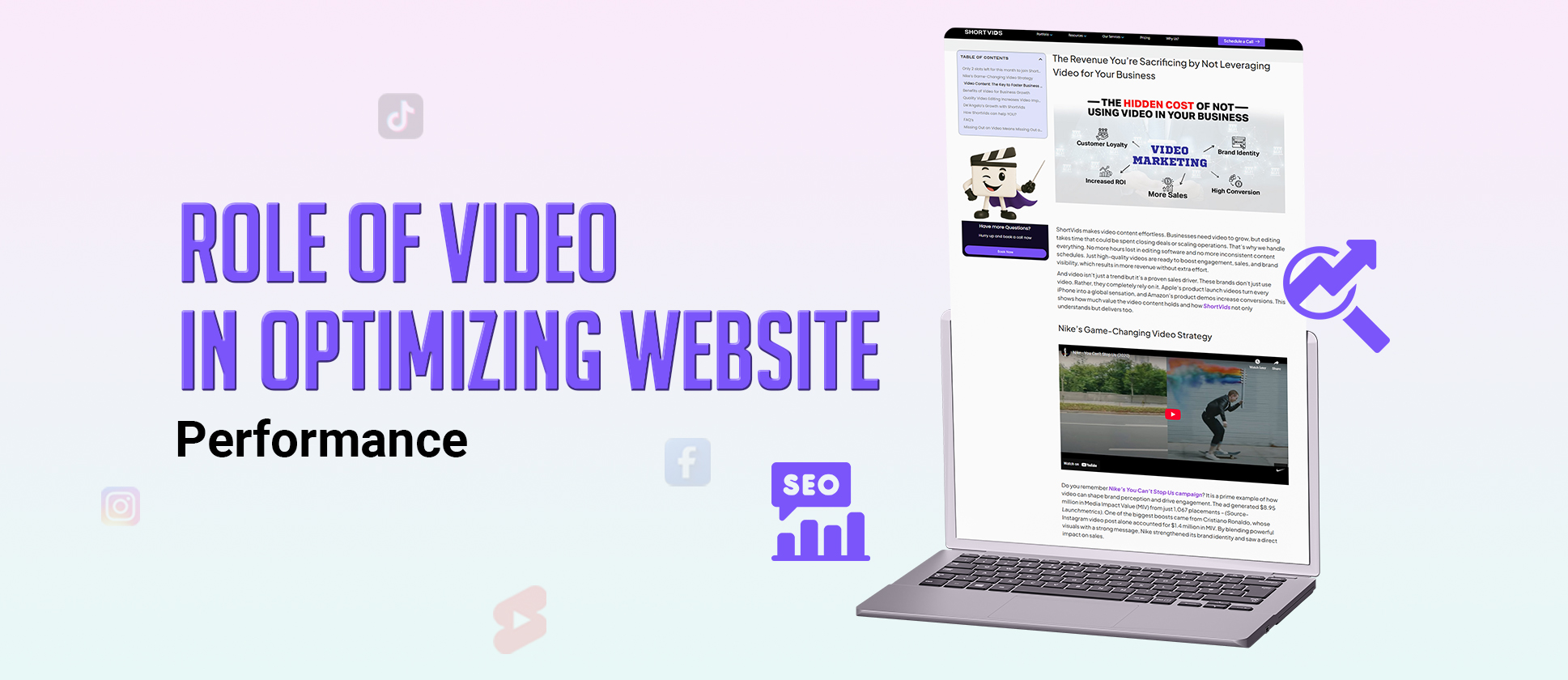There is a reason you can’t scroll for more than three seconds without bumping into a video. Everyone’s watching them. Everyone’s sharing them. And guess what? Search engines love them too. Pages with Videos can drive anywhere from 41% to 157% more organic search traffic compared to text-only content. That’s why video SEO is now a key strategy if the goal is to actually show up when someone Googles what your business does.
Adding video isn’t just about wowing your visitors. It’s also about showing Google that your content is useful, engaging, and worth ranking higher. Let’s get into exactly how this works. But here’s the thing. Most websites still treat video as a bonus add-on. Something nice to have but not really essential. That’s a big mistake because video content for SEO is up to 50 times more likely to reach the first page of Google search results than plain text alone. So clearly, if you are not Leveraging Videos, then you are leaving a lot of money on the table.
How Video Content Affects Search Engine Optimization
If video is added the right way, it becomes a powerful tool to increase website traffic. Search engines pick up on those extra signals: user engagement, time-on-site, reduced bounce, and reward you accordingly. That’s what makes video marketing SEO essential for modern rankings.
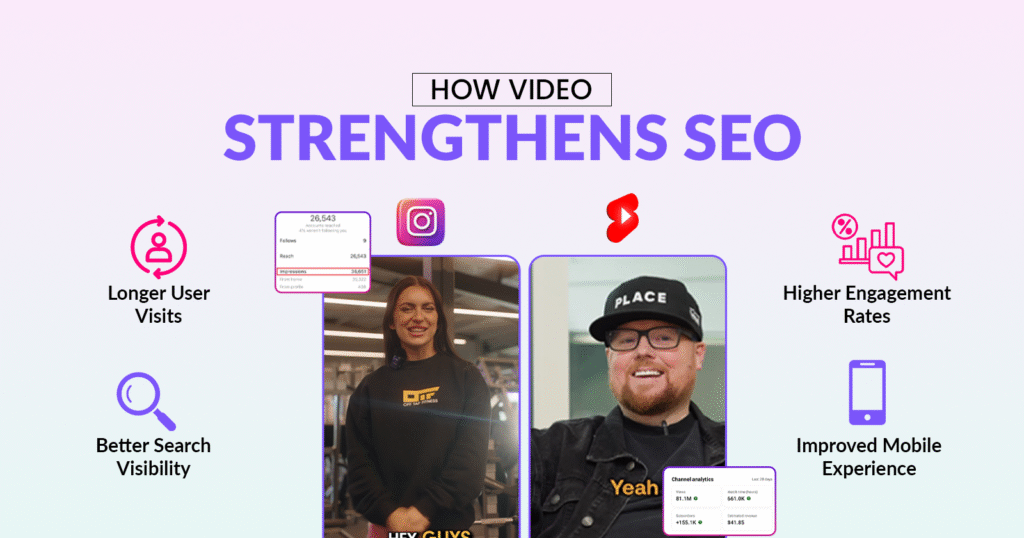
Increases Session Duration
When someone clicks play on a video and stays to watch it, they’re spending more time on your site. On average, users spend 1.4× more time on pages that include video compared to text-only pages. It also keeps people engaged longer without bouncing away.
As a Benchmark, sites with average session durations over 2 minutes tend to perform better in search rankings, and durations of 3–4 minutes or more are considered exceptional in many industries. This extra session time tells search engines your content is worth exploring. That’s another reason brands now improve SEO with video to extend dwell time and build stronger user signals.
Boosts Audience Interaction
Videos naturally drive more interaction. Viewers click through. They share the video or comment on it. They watch it again and sometimes even send it to a friend. When a video is embedded, users are 88% more likely to stay on the site, increasing dwell time, reducing bounce rates, and improving your video marketing SEO score. All this activity helps build trust and improves your engagement score.
Enhances Content Indexing
When videos are embedded using schema markup and proper metadata, search engines can understand them better. This allows Google to index the content and potentially display it as a video result or rich snippet. Embedding videos with proper schema markup and metadata helps Google index them correctly, and often earns you a video-rich snippet in SERPs, with a Thumbnail and duration that increases click-through rate by around 41%, a big win for video content for SEO.
Strengthens Mobile Friendliness
Videos are easy to consume on mobile, and when served fast and responsively, they lower bounce rates on mobile and improve mobile SEO signals. If your site loads quickly and your videos play smoothly, that mobile-friendly experience can lead to better rankings across all devices. Video is easier to consume on a smartphone than reading long-form content.
Common Questions About Using Video to Boost SEO
These are actual phrases people type into Google or ask their voice assistants. Answering them naturally is a great way to rank for video SEO and search engine optimization with video.
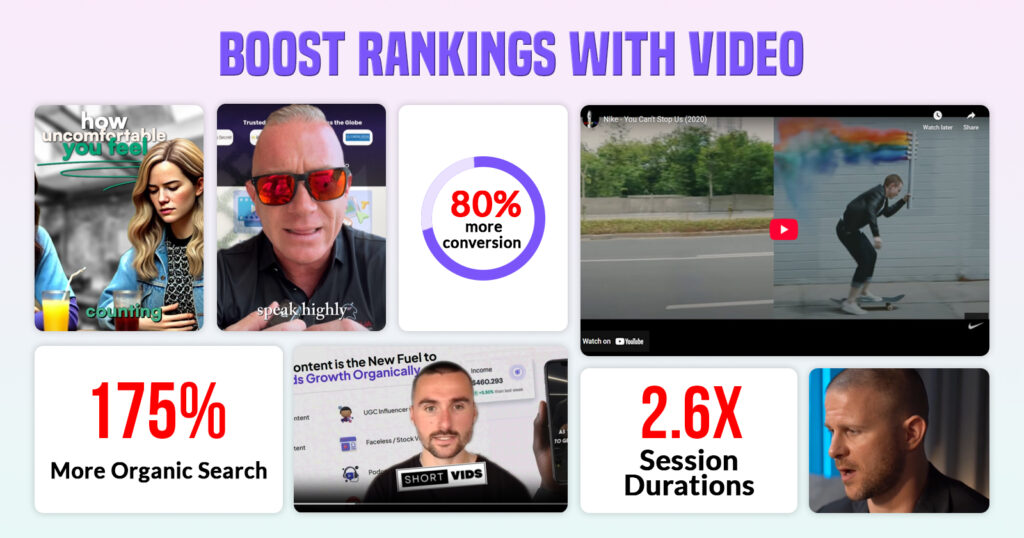
Can Videos Help Improve SEO?
Absolutely. Videos help users stay longer, interact more, and link to your site, all signals that improve SEO with video organically. When they do, Google takes that as a good sign. They also generate shares and backlinks and help with content clarity. All this supports better rankings and long-term visibility.
- Websites with video content see up to 157% more organic search traffic compared to text-only pages.
- Embedding video can raise organic traffic by around 41%, signaling higher value to search engines.
- Pages with video typically have 2.6× longer session durations, and landing pages with video convert 80% more often.
Which Video Types Support SEO?
It really depends on what your audience needs. Just make sure the content solves a problem or answers a question.
Product demos, tutorials, interviews, behind-the-scenes walkthroughs, and even explainer Animations are the heavy-hitters of video content for SEO because they drive engagement and help answer real questions.
- Product demos & tutorials: Educate and keep users engaged longer, boosting dwell time.
- Explainer animations: High retention viewers retain 95% of a message when watching vs just 10% when reading.
- Behind‑the‑scenes, interviews, walkthroughs: Help humanize your brand and encourage interaction/sharing.
- Short-form (e.g., Shorts, Reels): These attract high views & likes per view, while traditional formats drive comments & deeper engagement.
Learn about the Video Strategy of your favorite business gurus.
What Does Video Optimization Mean?
Use keyword-rich titles, compress file size, add captions, provide transcripts, and include schema tags for indexing support.
It means making the video easier to find and understand for both users and search engines.
- Keyword‑rich titles and descriptions, optimized metadata, and tags improve indexing and ranking potential.
- Adding closed captions and transcripts boosts accessibility and indexability, and pages with transcripts see ~16% revenue lift post-addition.
- Use structured data (video/schema markup) so Google can feature rich snippets with thumbnails, boosting CTR by around 41%.
- Google prioritizes video pages that work seamlessly across devices.
Make sure you show them fast-loading video and responsive delivery, especially for mobile users.
Should I Use YouTube or My Own Site?
If discoverability is your priority, YouTube is great. But if time on site and conversions matter more, self-hosted or embedded videos work better. A mix of both often gets the best results for SEO and user experience.
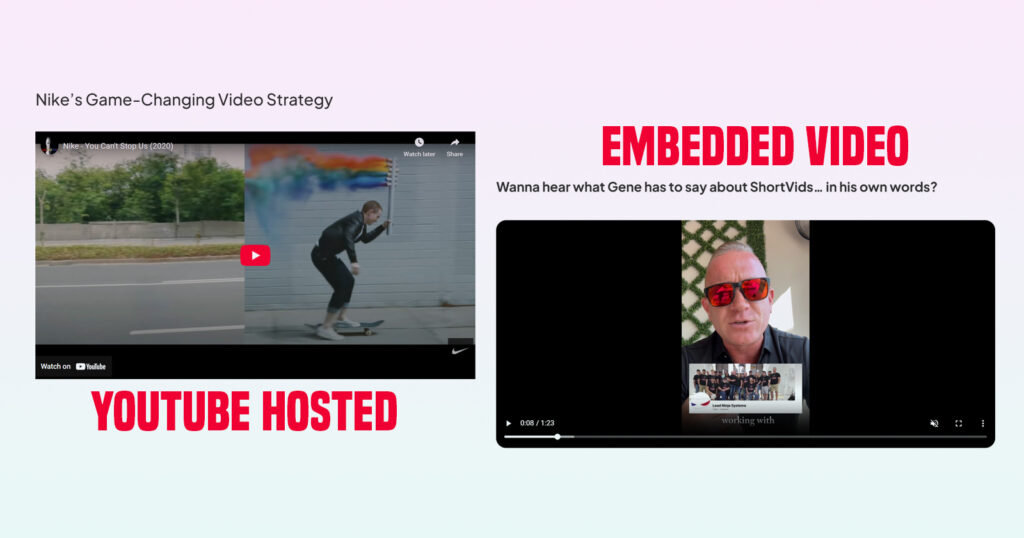
Both have their place. Here’s how they stack up:
- YouTube-hosted video: Great for discoverability. YouTube is the second-largest search engine; optimized listings there often appear in Google’s video carousel.
- Embedded / self-hosted video: Embedded video still counts for SEO, especially when metadata and schema are implemented.
Best for keeping users on your site, boosting time-on-site, and conversions.
- Hybrid strategy (YouTube + embed): Strongly recommended for full SEO benefit. Helps you capture external search while retaining user engagement and analytics.
SEO Benefits of Adding Video to Your Website
Videos can hold attention, explain complex ideas quickly, and make your content more engaging across devices. Adding video to your website isn’t just about looking good; it helps your pages perform better in search.
Search engines notice when users stick around, interact, and share. Plus, with the right technical setup, like schema markup, your videos can help Google better understand and rank your pages. Here’s a quick breakdown of the key SEO benefits video brings:
| Benefit | Description |
|---|---|
| Longer time on site | Viewers spend more time on pages with embedded video |
| Higher engagement rates | Users click, play, share, comment, and interact more often |
| Improved indexing and crawlability | Schema markup and sitemaps help Google understand your content |
| Better user experience | Videos are easier to digest than text, especially on mobile |
| Increased backlinks | Valuable video content often gets shared and linked to |
| Higher CTR in search results | Thumbnails and rich snippets draw more clicks |
Did You Know?
Over half (51%) of video marketing professionals globally say video delivers the highest ROI compared to any other content format. (source: Vidico)
Embedding Videos Boosts Visibility and Engagement
Embedding video directly into your pages is a powerful move. Videos that are properly embedded often qualify for rich results in Google. It doesn’t just keep people around longer, but also helps Google interpret your page better. That gives you an edge in visibility, especially if the thumbnail draws attention.
Encourages Deeper Browsing
Embedding video creates a “hook” effect; users spend more time and tend to explore further on your site, often leading to 2–3 internal clicks per session, and once a video hooks someone, they’re more likely to keep scrolling through your site. This ripple effect means more interaction with your other content. That’s great for SEO and even better for conversions.
Reduces Bounce Rate Naturally
Video helps reduce bounce rates without forcing anything. Pages featuring relevant video content see reductions in bounce rate: users are 88% more likely to stick around on Video-Embedded Pages. A well-placed video answers questions, explains concepts, or demonstrates a product. People stick around for that, and search engines notice.
Supports Keyword Context
Neil Patel’s blog explains how adding video transcripts and closed captions can dramatically improve SEO. He notes that transcripts allow search engines to crawl spoken content, enhancing keyword coverage and context across long‑tail queries. This strategy helps your page rank for more diverse search terms, not just those in titles or tags.
He also highlights data like captions boosting video viewership by up to 80%, which in turn signals engagement to search engines and supports video SEO.
Example in action:
Imagine a tutorial video titled “How to use product X for beginners.” The transcript includes the phrase “how to use product X for beginners” along with variations like “beginner guide product X,” “getting started with product X,” and “product X tutorial.”
That helps reinforce search engine optimization with video through varied but relevant keyword mentions, improving overall relevance and indexing potential. As visitors skim or engage with the transcript, Google sees the natural language match for these conversational queries.
Powers Multimedia SEO
Video breaks up text-heavy pages and adds a layer of multimedia richness that most competitors ignore. Google prefers varied content formats. That gives your site a competitive edge with very little extra effort. Pages enriched with a mix of formats like video, images, text, and captions generally rank better: video pages see 41% higher click-through rates (CTR) versus text-only pages.
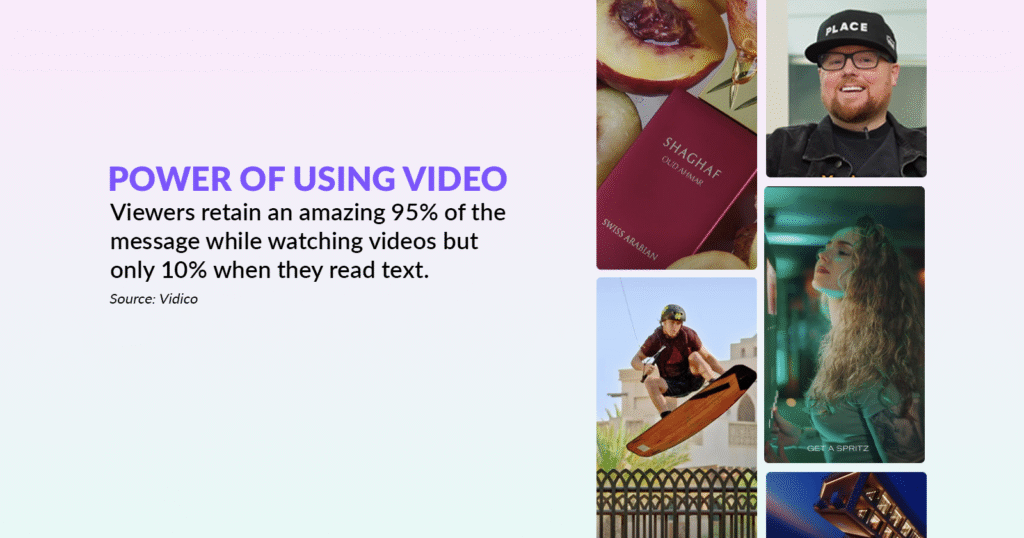
How Video Marketing Supports Broader SEO Goals
Videos don’t work alone. They fit into your wider digital strategy. And when used right they power up every Other Type of Content you’re already investing time and effort into. It’s the one medium that Adapts to Every Platform.
Builds Linking Opportunities
Well-made Videos that explain complex topics or showcase helpful walkthroughs often earn backlinks. This gives your site domain authority, which boosts SEO. Other websites embed them in blogs or link to them from newsletters.
Ahrefs published a video tutorial on SEO analysis that was embedded by dozens of high‑authority blogs. As a result, the page earned 15+ backlinks from educational sites, boosting domain authority and search rankings.
Boosts Trust and Credibility
Seeing a real person speak or demonstrate something is way more credible than just reading text. Over time, this builds audience trust and strengthens your SEO authority. Video helps establish that personal connection.
Dollar Shave Club’s viral intro video put the founder front and center. That personality‑driven content increased subscriber trust and led to massive social shares and press mentions, positioning the site as trustworthy in Google’s eyes.
What are the Top Marketing Campaigns to try in 2025?
Helps Stretch Your Content
More assets mean more indexed content and more chances to appear in results.
And your one video becomes multiple assets. Pull quotes for social. Repurpose your Long Form videos into a blog post. Or convert them into shorts for Instagram.
Toggl Track filmed a single explainer video but turned it into 10+ repurposed assets: blog posts, social shorts, and email clips. This approach led to consistent content output and multiple indexed assets from one recording.
Increases Topic Relevance
When your video dives deep into a specific question or problem, it boosts page-level relevance. That increases your chances of showing up for long-tail and conversational searches. Brafton (via Yans Media case study) added testimonial videos to their homepage. That led to a 113% increase in click‑through rate, which signaled to Google that the page was highly relevant to users’ queries.
Ways To Improve SEO With Video Today
These practical tactics work whether you’re new to video or already publishing regularly. There are simple steps to start boosting rankings through video without spending a fortune.
- Add tutorial or testimonial videos to key landing pages
- Use natural language in titles and filenames
- Write engaging metadata and use structured data
- Compress video files for fast load time
- Always provide transcripts and captions
If you do these consistently and make the content truly useful, you’ll see real improvements in your site’s SEO performance. It’s not just about having a video. It’s about what that video does.
How ShortVids Makes Video Content for SEO Easy
Making videos that rank well takes time and consistency. That’s where most people hit a wall. ShortVids is here to remove that wall completely. We make the process simple, fast, and results-focused.
We don’t charge per hour, nor do we limit edits. At ShortVids, we just make sure your content looks better, ranks higher, and works harder for your brand.
With ShortVids, your business gets a team, not just editors but project managers and coordinators who ensure everything is done right and on time.
Josh Peacock, founder of SEO for Hire, was facing exactly that problem. He had ideas, content goals, and zero editing capacity. We helped him turn ideas into high-quality clips daily. That meant faster publishing, more views, better rankings, and more leads. He didn’t just get videos, he got a growth system.
ShortVids gives you peace of mind. Your video SEO will never fall behind again.
Final Thoughts on Using Video to Improve SEO
If your site still treats video like a side feature, it’s time to fix that. Start embedding useful, helpful, optimized videos that solve real problems.
Use schema. Add captions. Make it watchable. Make it useful.
And if doing that consistently sounds like a lot, ShortVids is here to help. If you want to see what the real SEO benefits of video look like, we’re only a message away.
Frequently Asked Questions
When videos are embedded properly and optimized with metadata, they can also appear in Google’s video results or rich snippets. Video SEO helps your website rank better by increasing session time, reducing bounce rate, and improving user engagement signals that Google uses to rank pages.
You can improve SEO with video by adding simple explainer videos or tutorials on key pages, using transcripts, compressing file size for fast loading, and adding schema markup. Even short clips work if they’re useful and relevant.
Video content for SEO is more engaging and easier to consume, especially on mobile. It holds attention longer and increases session time by up to 2.6×. These signals tell search engines that your page is more helpful, which helps you rank higher.
Definitely. ShortVids makes it super easy to create high-retention content that keeps people on your site longer. That extra session time improves engagement signals and helps your site rank better. You get high-quality edits without ever worrying about file formatting, schema, or metadata; we handle it all.
Book a Call Today
- Fixed monthly plans starting at $999
- 24-hour turnaround time (or less) on all short-form edits
- 3-layer quality check system on every video
- No more chasing freelancers or managing editors
- Scale up to 50+ videos/month without hiring in-house
- Content team trained on platform trends, scroll-stopping hooks & storytelling
- Fully managed by professionals – you just upload & approve
- Response time: Under 1 hour (US & GCC time zones)
Cut your production costs, not your standards.

